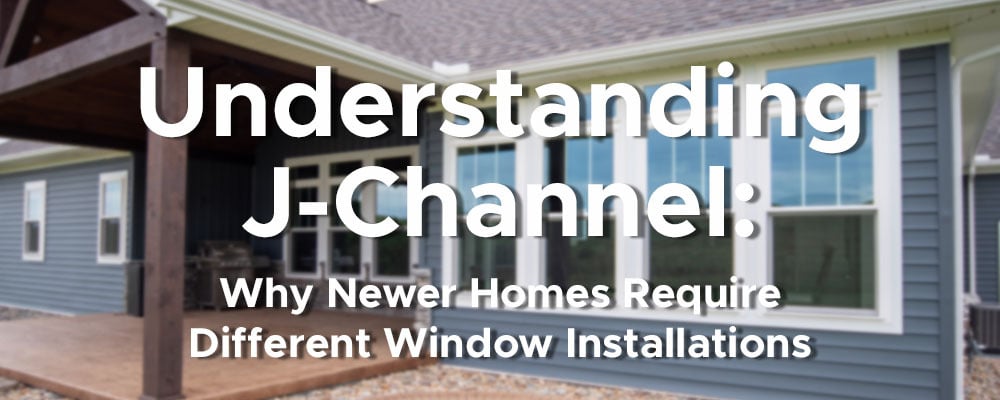Understanding J-Channel: Why Newer Homes Require Different Window Installations
June 9th, 2025
4 min read
By Jeff Blank

If your home has vinyl siding and you're replacing your windows, you've probably heard the term “J-channel” tossed around — but no one’s really explained what it is or why it matters. When installed incorrectly or overlooked, this small piece can cause major issues like water damage, mold, or energy loss.
At Energy Swing Windows, we've helped hundreds of homeowners across Pittsburgh identify and fix J-channel-related problems. Often, after another contractor cut corners or didn’t understand how vinyl siding works.
In this article, we’ll break down exactly what J-channel is, why it’s essential for homes with vinyl siding, and what you should ask your installer. That way you can avoid costly headaches and make smart window replacement decisions.
What is J-Channel in Window Installation?Simply put, J-channel is a specially designed vinyl trim piece that neatly finishes off the edges around your windows and doors. It creates a "finished look" where your siding meets these openings. Picture a piece shaped like a "J" (hence the name.)
J-channel serves two essential purposes:
-
Gives a finished, clean look around windows and doors.
-
Directs water safely away, protecting your home from moisture damage.
Years ago, when aluminum siding was common, aluminum J-channel was popular. Today, it's almost exclusively vinyl, designed to match your siding seamlessly.
Why Do Newer Homes Use J-Channel for Windows?
Understanding the shift in home construction helps explain why newer homes typically require J-channel. Vinyl is now a popular siding option because it's flexible, low-maintenance, and resistant to weather damage.
Unlike traditional materials such as brick or wood, vinyl expands and contracts with temperature changes. J-channel accommodates this movement, ensuring a secure, watertight seal around your windows.
Additionally, more and more windows now come with a J-channel built-in as part of the window frame. This built-in J-channel makes window installations quicker and simpler during new construction. In contrast, it can sometimes complicate window replacements.
If you live in Pittsburgh and your home was built within the last 25 years, there’s a good chance your windows have integrated J-channel.
How Does J-Channel Protect My Home?
J-channel isn't just for aesthetics. It's a crucial component in protecting your home against Pittsburgh’s weather:
-
Prevents moisture from entering around windows, avoiding water damage and rot.
-
Acts like a small gutter system, directing rainwater safely around the window.
-
Reduces potential mold growth and insect infestation caused by moisture problems.
What's the Difference Between J-Channel and Traditional Window Trim?
Now that we've covered why J-channel is essential, let's highlight how it differs from traditional window trims. These are common in older homes, typically done with wood frames or aluminum flashing around the exterior of the window:
Feature |
J-Channel |
Traditional Trim |
| Moisture protection | Excellent (channels water away) | Moderate (requires sealing) |
| Maintenance | Minimal | Regular painting or sealing |
| Aesthetic Flexibility | High (many color options) | Limited |
How Do I Know If My Home Requires J-Channel?
To determine whether your home needs J-channel, consider the following:
-
Homes with vinyl siding always use J-channel.
-
Windows surrounded by brick do not need J-channel.
-
Wood or aluminum siding don’t always need a J-channel, but they benefit to having one at least at the top
If your home has mixed siding, such as brick lower levels and vinyl upper floors, the vinyl sections will definitely use J-channel.
What Are the Risks of Improper Window Installation Without J-Channel?
Knowing the importance of proper installation helps you avoid several potential issues:
-
Moisture intrusion causing structural damage.
-
Increased energy costs due to improper sealing.
-
Reduced lifespan for both siding and windows.

This is typical j-channel around a window. Unfortunately, with this installation, there is a notch out to fit the back of the j-channel around the window. This is an improper way to install a J-channel because it can potentially allow water to get into the home.
What Are Signs of J-Channel Failure After Installation?
Identifying potential issues early helps prevent costly repairs. Watch out for these signs of J-channel failure:
-
Visible water streaks or stains on siding below windows.
-
Drafty windows indicating poor sealing.
-
Mold or mildew on interior walls near window frames.
If you notice any of these symptoms, contact a professional for a detailed inspection.
How Can Someone Inspect Their Own Siding or Windows to Check for J-Channel?
A simple homeowner inspection can quickly reveal the condition of your J-channel:
Step-by-Step Homeowner Inspection Checklist:
-
Visually inspect the trim around windows and doors for visible cracks, gaps, or loose sections.
-
Gently pull or press on the trim; integrated J-channel won't move, while detached or failing trim may shift.
-
Look for water streaks or discoloration beneath your windows—clear indicators of moisture problems.
-
Check interior walls and window frames for signs of mold, mildew, or dampness.
-
On a windy day, run your hand along the edges of your windows inside your home to feel for drafts.
If any issues arise during your inspection, consider reaching out to a trusted professional like Energy Swing Windows for a thorough evaluation.

Can You Add J-Channel Later If Your Home Doesn’t Have It?
If your home doesn't already have J-channel, it likely doesn't need it. However, if you're replacing windows that have the J-channel built-in, you'll have some additional work:
-
Removing built-in J-channel requires new vinyl trim installation.
-
Retrofitting the J-channel itself is affordable ($15–20 per window). Keep in mind, adjusting the existing siding can increase overall complexity and cost.
An experienced window installer knows the best methods for achieving the integrity you need to keep water from getting into the new frame and your home.

How Do You Find a Contractor Who Installs J-Channel Correctly?
To ensure a smooth installation experience, selecting an experienced, trusted installer is key:
-
Look for installers familiar with modern siding and window integrations.
-
Verify warranty coverage, installation guarantees, and past customer reviews.
-
Discuss clearly how they plan to finish and seal windows to protect your home.
Don’t Let a Small Trim Cause Big Problems
If you’ve ever replaced a window or worked with siding, chances are you’ve heard the term “J-channel” without getting a clear explanation. And like many Pittsburgh homeowners, you may not have realized just how important this small piece of trim really is — until something went wrong.
Now that you understand what J-channel is, how it functions, and why it’s essential for newer homes, you’re in a stronger position to avoid the most common and costly installation mistakes. You know what signs to look for and what questions to ask your contractor before moving forward.
Your next step is to use our free window pricing calculator to get a sense of what your project might cost. No pressure, just helpful information. And if you’re ready to make sure your window replacement is done right from the start, we’re here to help guide you every step of the way.
Jeff Blank is the Operations Manager at Energy Swing Windows and has been with the company since day one. He oversees every aspect of installation with a deep commitment to doing things right. No shortcuts, no guesswork. With decades of hands-on experience, Jeff is the go-to expert when it comes to what really makes a great installation.


